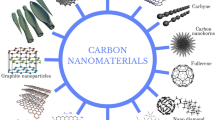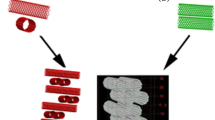Abstract
Multilayer carbon nanotubes formed by the mechanical activation obtained by the mechanical activation of amorphous carbon are investigated. The amorphous carbon is produced by the pyrolysis of plant matter—specifically, brown sphagnum moss (Sphagnum fuscum) and Magellan’s peat moss (Sphagnum magellanicum), corn shoots, spiny bamboo (Bambusa blumeana schultes), cotton, and okra stalks (Abelmoschus esculentus). The carbon nanotubes are formed by pyrolytic and mechanochemical technology. Amorphous carbon is produced at 950°C and then subjected to mechanochemical treatment in a planetary mill for 1–46 h. The amorphous carbon is removed by three-stage vacuum annealing at 220–870°C. The greatest quantity of carbon nanotubes is produced after 36-h mechanical activation, for all types of nanopowder. More prolonged mechanical activation leads to the formation of (20–100)-μm aggregates, and the thermal stability of the multilayer nanotubes is lost.
Similar content being viewed by others
References
D’yachkov, P.N., Uglerodnye nanotrubki: stroenie, svoistva, primenenie (Carbon Nanotubes: Structure, Properties, and Applications), Moscow: BINOM, 2006.
Mishchenko, S.V. and Tkachev, A.G., Uglerodnye nanomaterialy. Proizvodstvo, svoistva, primenenie (Carbon Nanomaterials: Production, Properties, and Applications), Moscow: Mashinostroenie, 2008.
Onishchenko, D.V. and Reva, V.P., High-energy processing of sphagnum moss to produce carbon sorbents, Coke Chem., 2012, vol. 55, no. 10, pp. 396–399.
Onishchenko, D.V., Reva, V.P., and Kuryavyi, V.G., Vacuum annealing of carbon nanotubes formed from amorphous carbon, Coke Chem., 2012, vol. 55, no. 12, pp. 467–469.
Onishchenko, D.V. and Reva, V.P., Hydrogen storage in multilayer carbon nanotubes, Coke Chem., 2013, vol. 56, no. 5, pp. 182–185.
Onishchenko, D.V. and Reva, V.P., Sorption properties of multilayer carbon nanotubes produced from cotton, Coke Chem., 2013, vol. 56, no. 7, pp. 262–265.
Onishchenko, D.V., Reva, V.P., Chakov, V.V., and Voronov, B.A., Kinetics of the formation of multiwalled nanotubes from moss, Khim. Tverd. Topl., 2013, no. 4, pp. 46–51.
Onishchenko, D.V., Reva, V.P., and Voronov, B.A., Sorptional activity of carbon nanotubes produced from sphagnum moss by mechanical activation, Zh. Anal. Khim., 2014, vol. 69, no. 5, pp. 451–455.
Onishchenko, D.V., Reva, V.P., Chakov, V.V., et al., Promising nanocomposites based on renewable plant resources, Metallurg, 2012, no. 9, pp. 59–62.
Onishchenko, D.V., Reva, V.P., and Chakov, V.V., Russian patent 2509053, Byull. Izobret., 2014, no. 7.
Balaklienko, Yu.M., Marmer, E.N., and Novozhilov, S.A., Refining carbon nanotubes and nanofibers in vacuum resistance electrofurnaces, Al’tern. Energ. Ekol., 2005, no. 10(30), pp. 89–92.
Huang, W. and Wang, Y., 99.9% purity multi-walled carbon nanotubes by vacuum high-temperature annealing, Carbon, 2003, vol. 41, no. 13, pp. 2585–2590.
Author information
Authors and Affiliations
Corresponding author
Additional information
Original Russian Text © V.P. Reva, A.E. Filatenkov, Yu.N. Mansurov, V.G. Kuryavyi, 2014, published in Koks i Khimiya, 2014, No. 11, pp. 34–38.
This article is dedicated to the memory of D. V. Onishchenko
About this article
Cite this article
Reva, V.P., Filatenkov, A.E., Mansurov, Y.N. et al. Thermal stability of multilayer carbon nanotubes produced by the mechanical activation of amorphous carbon. Coke Chem. 57, 444–447 (2014). https://doi.org/10.3103/S1068364X14110088
Received:
Published:
Issue Date:
DOI: https://doi.org/10.3103/S1068364X14110088




